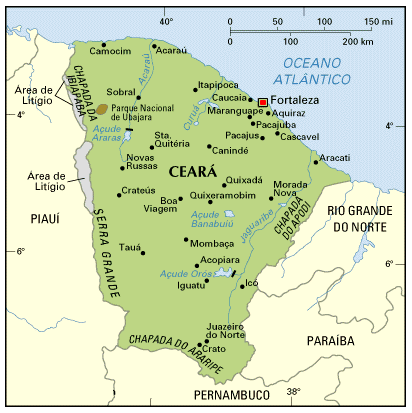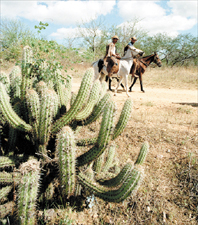Geography of Fortaleza and Ceará
 Fortaleza
Fortaleza Ceara
CearaClimate
Climate of Ceará is predominantly semi-arid. This climate is characterized by high mean temperatures and low pluviosity levels (check out this graph of temperature and raining in Fortaleza); in the areas of higher altitude (see Topography), average temperature is lower, and precipitation levels are higher. A good part of Ceará is included in the Polygon of Drought (in Portuguese, Polígono das Secas); this area is defined by law, and cities within it are under permanent attention of official social agencies.
The semi-arid area is called sertão; to adapt to the tough conditions, people who live in sertão created a different way of living, with influence on the way they make food, sew clothing, and even play their songs. This culture is called sertaneja, and, over the past years, has gained a space in the fashion world of the large Brazilian cities.
The dryness of the climate (which has influence both on natural vegetation and on grown by man plantations) was a factor to prevent the early development of the region; History registers several occasions where years passed with extremely low precipitation levels (Pero Coelho de Souza, the first European to try to settle in Ceará, had to face one such drought period - see History of Fortaleza and Ceará). Nowadays, Fortaleza takes advantage of the climate: during the dry season, it is very rare to see unexpected rains.
Topography
 The State of Ceará has about 570 km of coast, a predominance of low altitude interior lands (lower than 200 meters), and practically all the borders of the State taken by Chapadas (Plateaus) or Serras (Mountain Chains).
The State of Ceará has about 570 km of coast, a predominance of low altitude interior lands (lower than 200 meters), and practically all the borders of the State taken by Chapadas (Plateaus) or Serras (Mountain Chains).
The highest point of Ceará is the Pico Alto, with 1,114 meters (3,654 ft), in the city of Guaramiranga, about 110 km Southeast of Fortaleza; the plateaus and mountain chains have altitudes between 500 m and 900 m, most covered with natural forests, and the presence of trekking paths and waterfalls is common. The government of Ceará is more and more emphasizing the tourist potential of the ecologial areas of the State.
The interior of the State (about 60% of the total area) is taken by the sertão.
Notice that Ceará doesn't have a transition zone between the wet coast and the arid interior, as it happens in most States of Brazilian Northeast (see, for example, this map of Pernambuco); the absence of this wet zone explains why sugar cane was (and still is) cultivated in most States of Northeast, but it was not in Ceará.
Vegetation

Photo of caatinga.
The cactus is a mandacaru
There are two important kinds of vegetation in Ceará.
In the plateaus and mountains, there is a vegetation which resembles the Mata Atlântica (Atlantic Forest), with mid-sized trees, permanent leaves, only one layer of cover trees; Mata Atlantica used to exist all along the Brazilian coast up to Rio Grande do Norte (most of the forest was devastated; see here).
In the semi-arid zone, the dominant bioma is called caatinga; this bioma only exists in Brazil. In the caatingas, there is a predominance of bushes, usually with small leaves (which fall during the dry season) and thorns; this is a way found by the plants to diminish the loss of water.
The mandacaru (see photo), is one of the most popular kind of cacti, used as source of water by humans and animals.See some photos of plants of caatinga.
In the strip near the coast, there is a profusion of plantation of cashew trees, with industrial use; this tree is resistant to tough climate and soil conditions; the asymetry of its trunk and branches (often twisted) is a consequence of the lack of water and minerals during the growth.
Fauna
In the caatinga, there is abundance of reptiles, particularly lizard and snakes. In addition, there exist rodents and many insects and arachnids.
The difficulty of finding water hinders the existence of big mammals in the area, but there exist wild dogs and other animals that feed mainly of rodents. Several species are risking extinction, as human action disturb the ecological balance of the region; some animals which used to be symbol of the caatinga, as the gato-do-mato (wild cat) and the jararaca (poisonous snake).